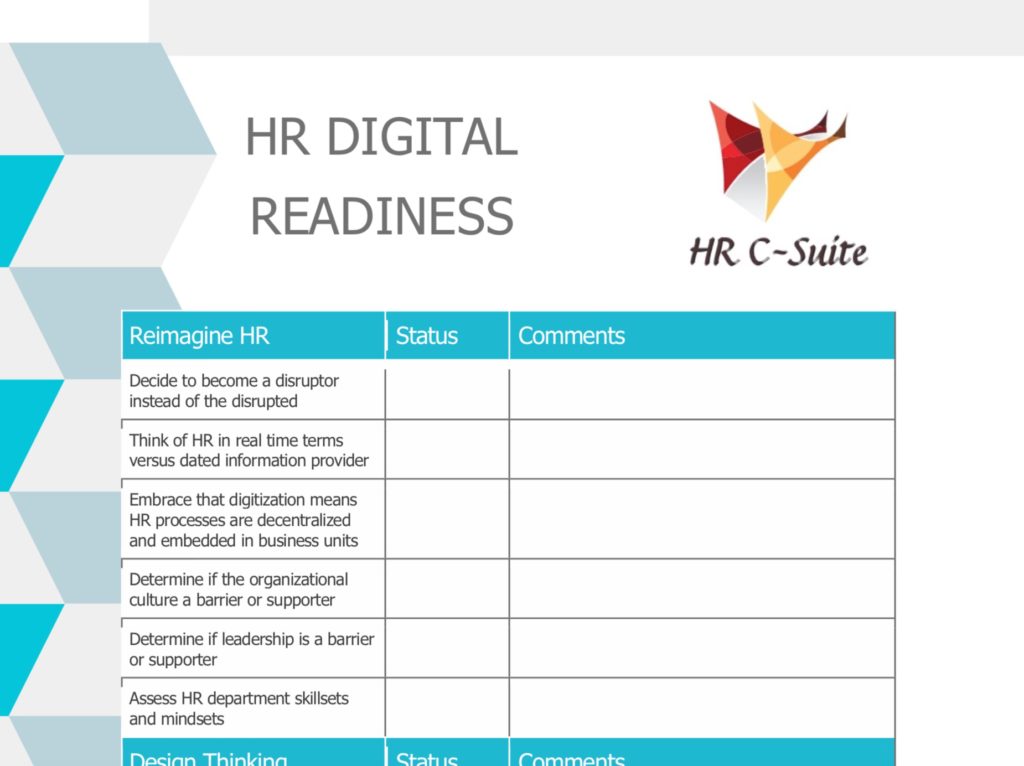Change can certainly be hard for any company or organization, but embracing the need for full digitalization of businesses is almost a necessity in today´s internet-dominated world. Younger generations of talented employees will almost certainly prefer companies who embrace the challenges and opportunities that come with the digital revolution, and increased productivity, a competitive edge, and optimized workplace efficiencies are other benefits that come with companies who open the doors to the inevitable digital revolution.
While digitalization is certainly a complex, involved process that requires participation and buy-in from all different sectors of a company, C-Level executives, HR executives, and business owners certainly need to be at the forefront of accepting and driving this change. Once CEOs and other C-Level executives understand the benefits that the digital revolution can bring to their company, they will be able to implement the digital transformation of the company through visionary leadership.
Below, we offer a concise introduction to some of the potential benefits that come with digital transformation. We also offer tips and strategies for how the digital revolution can best be implemented as part of a top-down approach, along with some examples, insights, and actionable strategies by business leaders around the world.
The Benefits of Switching to Cloud Computing Services
A recent study by found that by the year 2016, spending on public cloud Infrastructure was set to grow to $173 billion in 2026. Cloud computing infrastructure offers numerous benefits to businesses, including increased productivity. In an increasingly global economy, digitalization including cloud computing software can allow companies to bring on board high quality employees from around the world. Instead of tedious and time consuming conference calls, cloud computing services can allow business executives and other chosen employees to work together anytime and from anywhere around the world. Instead of spending thousands of dollars to send employees on business trips around the world to meet with important clients, cloud computing can allow C-Level executives to train a global workforce who can share information continuously and work collaboratively on projects even if they live on opposite sides of the world.
Another benefit of making the transition to cloud computing services is that it increases the security of confidential documents shared across the organization. According to one recent survey, 94 percent of business executives reported feeling more secure once they made the switch to cloud computing infrastructure. Through adopting this aspect of the digital revolution, a series of offsite servers with rigorous security measures will help your company avoid any potentially devastating data breaches.
How to Deal with an Overload of Information?
One of the chief challenges that comes with running a successful business or organization in today´s world is finding a way to deal with the enormous amount of information that is available. Whereas executive leadership several decades ago might have sent out a weekly memo to their staff or looked through a few pages of industry trends and market tendencies, today CEOs and other C-Level executives are simply overloaded with the amount of information at their disposal. Instead of feeling overwhelmed by this enormous amount of available information, computer learning and artificial intelligence (AI) technologies can help businesses take advantage of the vast amount of information and data that is relevant to their business.
John Gillespie, the CIO of Amnesty International, recently told the Guardian how this major human rights organization was using artificial intelligence (AI) computer programming to help the organization access and analyze enormous amounts of publicly available data. Instead of having interns read through thousands of pages of documents, case studies, and news feeds regarding human rights abuses around the world, Gillespie has put into place AI and machine learning technology to help his company extract important insights related to the work the organization is involved in from a constant stream of information.
Big data that is collected and stored by companies can take advantage of machine learning technologies to gain a competitive edge. For example, these cutting edge technologies can analyze data coming from business transactions to help your company identify new market opportunities. Furthermore, through analyzing publically-available social media profiles, machine learning can help companies come up with new product development ideas that follow from the trends of customer needs and satisfaction.
Digitalization to Find and Train Employees
If digitalization is going to be successful for any given business, it needs to be accepted and implemented by all members of the organization. While C-Level executives can create the plan for the digital transformation of the company, individual employees also have to be digitally competent in order to implement those changes. Fortunately, the digital revolution of business also offers a number of tools to help companies find and train a high talent workforce.
Through digitizing the recruitment process, HR executives can reach more high quality candidates, assure an improved candidate experience throughout the interview procedures, lower their overall recruiting costs, and reap the benefits of data-driven decision making. This will help companies find employees who can seize on the opportunities and the competitive edge that comes with digitalization.
Furthermore, digitalization can also be a helpful to train and supervise a digitally competent workforce. Vishy Narayanan, chief digital officer of the leading professional services firm PwC Australia has recently embarked on a digital transformation of the company aimed at completely overhauling the legacy tech infrastructure that the company had been depending on for a number of years. While much of this overhaul has been focused on switching to cloud computing infrastructure, his company has also embarked upon an ambitious employee training program focused on helping all members of their workforce team understand and take advantage of the full digitalization of the company.
Narayanan has put into place a “digital IQ program” for all employees. This program consists of a comprehensive tech assessment which allows company leadership to determine the digital competency of certain employees and come up with personalized training agendas to help employees learn what they need to know to better do their tasks. Furthermore, this digital IQ program also includes what Narayanan calls a “digital accelerator” which focuses on training employees on how to take advantage of leading tech developments such as AI and user experience technology to improve their overall productivity.
Lastly, digitalization can also help HR executives within a company implement solutions focused on employee transparency and productivity. Time and attendance software can be used by companies to oversee employee activity and thus help to improve productivity and maximize profit. This is especially important for companies with a global workforce who rely on cloud computing software for virtual collaboration on projects around the world.
The digitalization revolution is not a thing of the future, but rather a necessity for companies who want to stay competitive and continue to grow as the economy transforms to the current times. The three tips or strategies shared above can help any company along the path of digitalization in order to gain a competitive edge, increase productivity, and stay relevant in the changing economy.

HR Digital Readiness Checklist
The checklist prompts thoughts around these factors:
- Reimagine HR
- Design Thinking
- Analytics and Reporting
- Security













